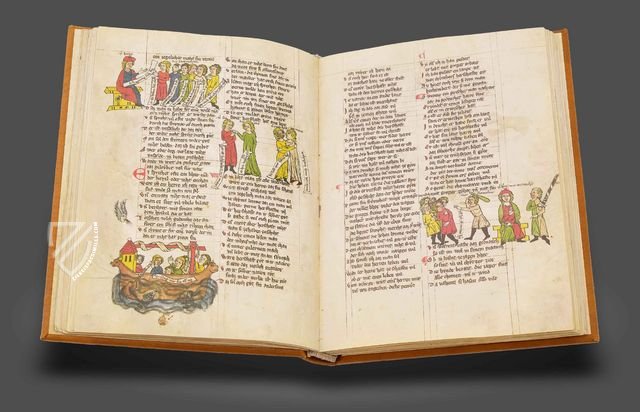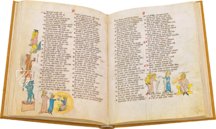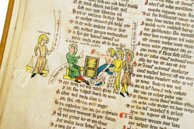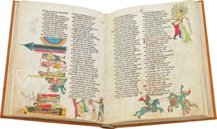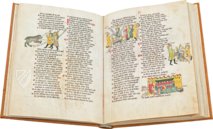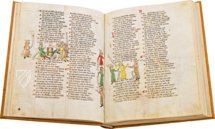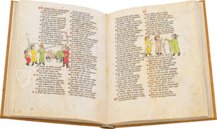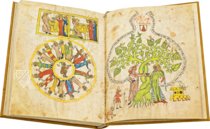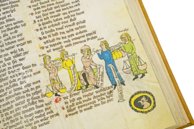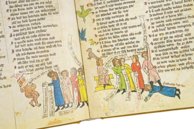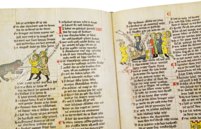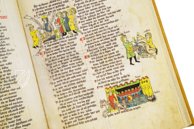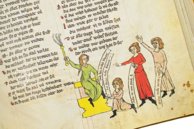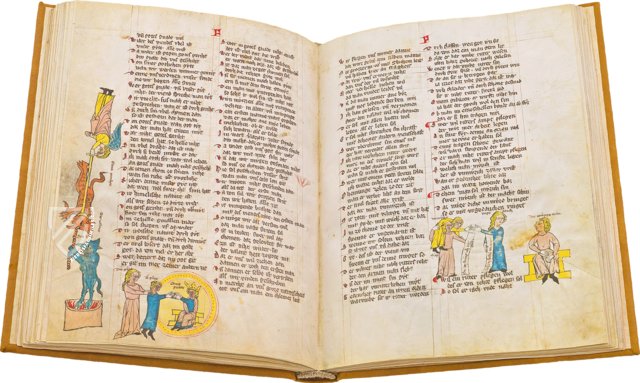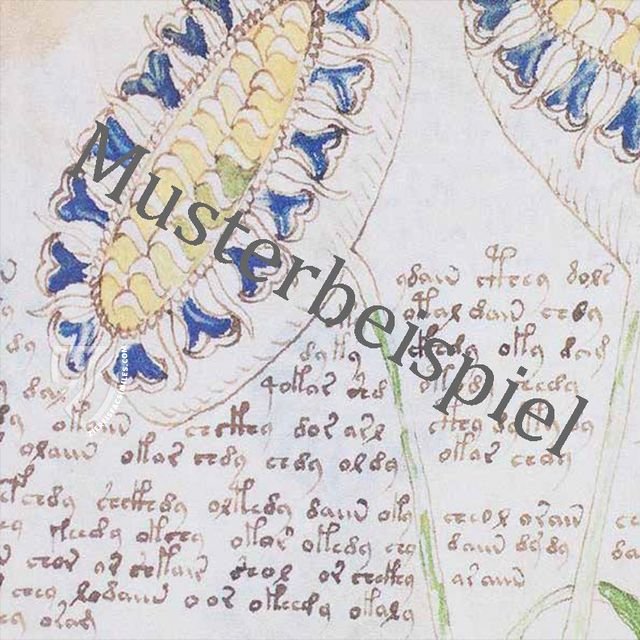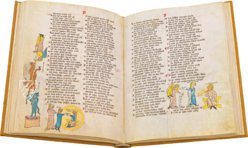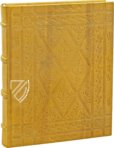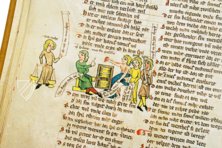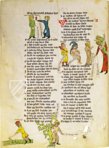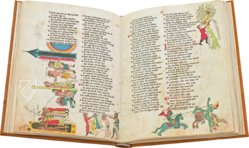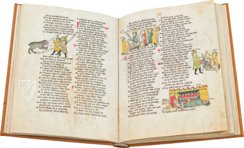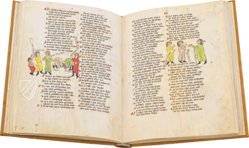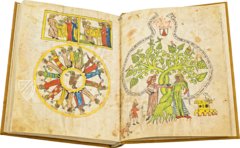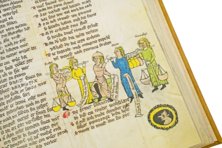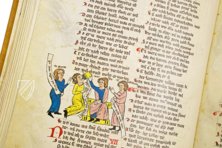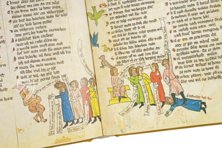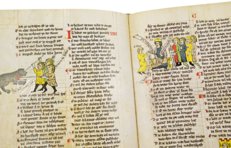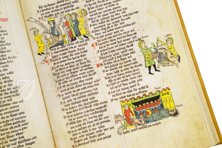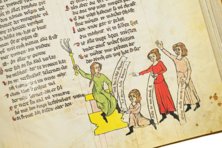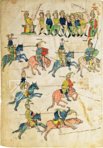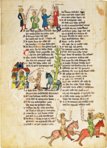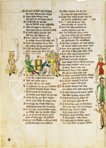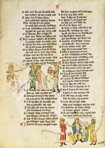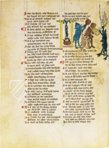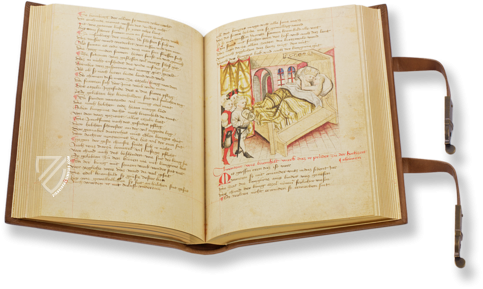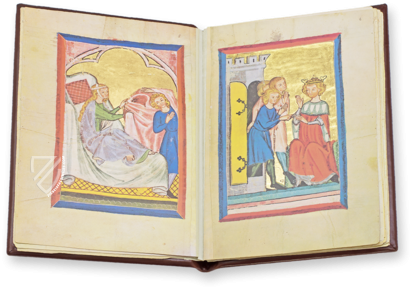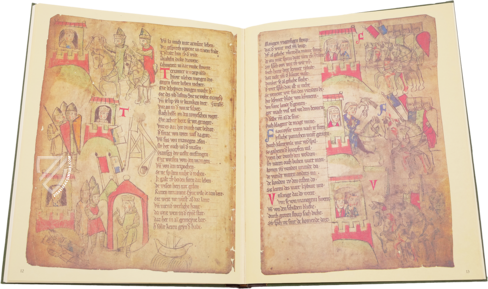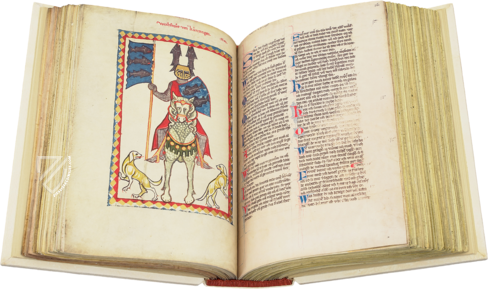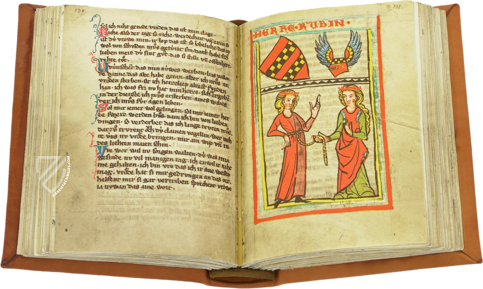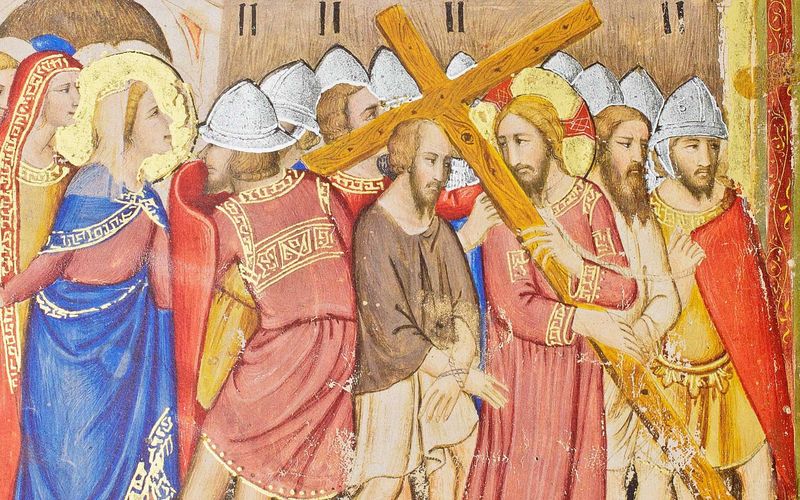Der Welsche Gast
(3,000€ - 7,000€)
With Der Welsche Gast, the Cleric Thomasin von Zerklaere (ca. 1186–1238) wrote the first book of etiquette in the German language ca. 1215/16. In the approximately 15,000 verses, he attempts to improve medieval society through education, upbringing, and guidance to virtuous behavior. A total of ten books give the reader both courtly and religious norms, which include, among other things, faithfulness in marriage and the duties of a good ruler. The edition of the Gotha Research Library, enriched with 120 miniatures, was created ca. 1340 and brings the world of thought in the Middle Ages back to life for today's readers. Battling knights, gambling men, animals, and angels romp on the sides, but even more unfriendly figures like the devil are also found.
Der Welsche Gast
Probably the most beautiful specimen of Der Welsche Gast is found in the Gotha Research Library. This poem comprising ca. 15,000 verses was composed by the cleric Thomasin von Zerklaere (1186–1238) ca. 1215/16 and is the oldest book of etiquette in the German language. Divided into ten books, it undertakes the attempt to improve society through education, upbringing, and guidance to virtuous behavior. Of prime importance here are values such as permanence, moderation, and generosity. All in all, the edition with 120 original miniatures of knights, animals and angels, which was made ca. 1340, illustrates the text for a better understanding.
A German Book of Etiquette from a North Italian Cleric
Much is not known to us today about the Romance-speaking Thomasin von Zerklaere (ca– 1186–1238) and his didactic poem. According to some information he wrote it in the winter of 1215/16 in just ten months. German was not the native language of the Northern Italian, who was well aware of his mistakes; he even apologizes to the reader for the linguistic shortcomings. But the Friuli-born cleric was not just responsible for the text. It can be assumed that he also designed the picture cycle himself.
Ten Books against Moral Decline
The doctrinal poem is dedicated to the the German-speaking nobility in the empire of the Hohenstaufen and Welfs, symbolized as a noble lady called "German tongue". Both participated in a bitter struggle for kingship since 1198. The author recognizes moral decline as a consequence of the conflicts and with his poetry undertakes the attempt by society to convey courtly and religious norms in ten books. These include, above all, table manners, faithfulness in marriage, the handling of earthly goods, the duties of a good ruler, and the effects of human action on future life in the afterlife.
Refreshing Miniatures for a Better Understanding
Proudly displaying 120 miniatures, the manuscript is extremely rich with decorations, which allow the conceptual world of the Middle Ages to come alive for the reader. The always unframed pictures show strongly gesticulating figures with curved banderoles, which act as speech bubbles. You can also find battling knights on horses, humans in a variety of activities, small animals, heavenly angels, but also sinister figures like the devil. As a reading aid, the illustrations visualize the text and the figures are mostly personifications of forces or ways of thinking that are in opposition to each other and influence people.
Codicology
- Alternative Titles
- The Romance Stranger
Welscher Gast
Der Welhische Gast
Der Wälsche Gast - Size / Format
- 204 pages / 32.5 × 23.5 cm
- Origin
- Germany
- Date
- 1340
- Epochs
- Style
- Language
- Script
- Gothic Textura
- Illustrations
- 120 miniatures painted in opaque watercolours, 119 of them illustrating the Welscher Gast, usually inserted into the columns, occasionally in the margins; occasionally half-page, three-quarter-page or full-page; dedication image added later, showing the coat of arms of the Bavarian noble family Raidenbuch
- Content
- The Gotha codex of the Welscher Gast is the most lavishly illustrated of all the manuscripts of the instructions in good conduct written by Thomasin von Zerklaere in 1215/16.
- Patron
- Unknown, presented as a gift to a noble lady
- Artist / School
- Thomasin von Zirclaere (author)
Der Welsche Gast
Backgammon
The game of backgammon has been played for over 5,000 years and was popular amongst the European nobility because of its perfect blend of strategy and luck. It is one of the world’s oldest board games and like chess had been studied by computer scientists. There is no authoritative text in regard to the rule of the game, but the “rules of play” are fairly uniform in international competition. The twelve points of each board are depicted in detail, as are the dice.
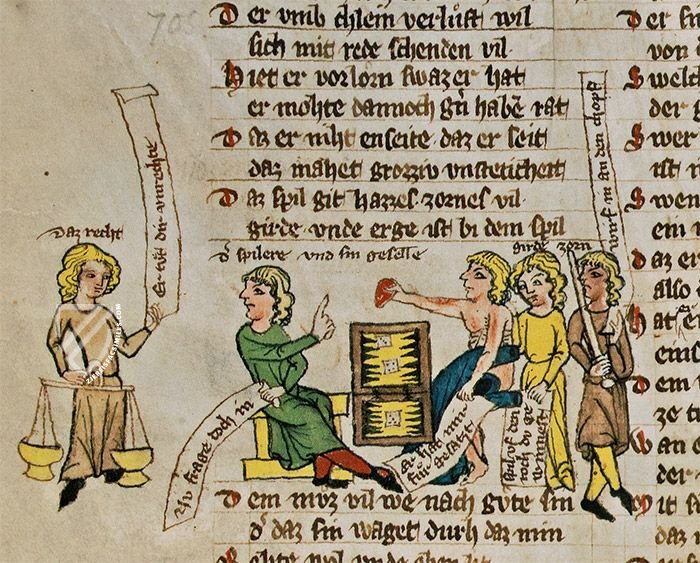
Der Welsche Gast
Battle Between Virtue and Vice
This moralizing manuscript, intended to teach a chivalric code of conduct, opens with a full-page tournament scene showing the battle between virtue and vice. Dressed in yellow and clapping her hands in the upper-left corner, Lady Virtue’s banderole exhorts her knights to “drive off the vices” while Lady Vice’s banderole instructs her knights: “protect yourselves against the virtues”.
In the field below, mounted knights engage in single combat, some wearing great helms: faithfulness against inconstancy, justice against injustice, moderation against immoderation, and generosity against avarice. The virtues are getting the better of the vices and chase them from the page, symbolizing that men can reformed through a moralizing education.
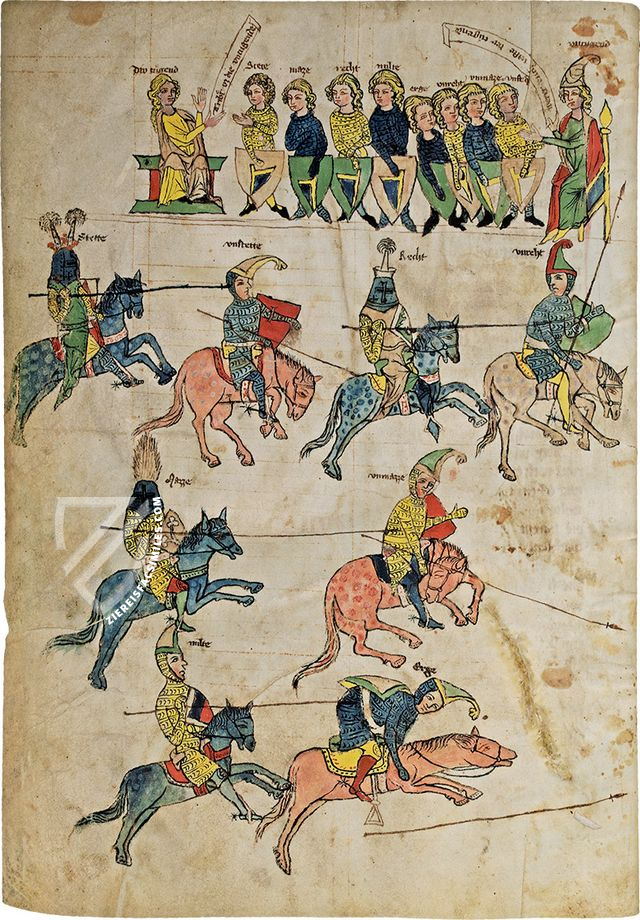
#1 Der Welsche Gast
Language: Deutsch
The commentary volume contains a complete transcription of the Middle High German text as well as descriptions and explanations of all 120 miniatures.
(3,000€ - 7,000€)
#2 Der Welsche Gast
(1,000€ - 3,000€)
- Treatises / Secular Books
- Apocalypses / Beatus
- Astronomy / Astrology
- Bestiaries
- Bibles / Gospels
- Chronicles / History / Law
- Geography / Maps
- Saints' Lives
- Islam / Oriental
- Judaism / Hebrew
- Single Leaf Collections
- Leonardo da Vinci
- Literature / Poetry
- Liturgical Manuscripts
- Medicine / Botany / Alchemy
- Music
- Mythology / Prophecies
- Psalters
- Other Religious Books
- Games / Hunting
- Private Devotion Books
- Other Genres
- Afghanistan
- Armenia
- Austria
- Belgium
- Belize
- Bosnia and Herzegovina
- China
- Colombia
- Costa Rica
- Croatia
- Cyprus
- Czech Republic
- Denmark
- Egypt
- El Salvador
- Ethiopia
- France
- Germany
- Greece
- Guatemala
- Honduras
- Hungary
- India
- Iran
- Iraq
- Israel
- Italy
- Japan
- Jordan
- Kazakhstan
- Kyrgyzstan
- Lebanon
- Liechtenstein
- Luxembourg
- Mexico
- Morocco
- Netherlands
- Palestine
- Panama
- Peru
- Poland
- Portugal
- Romania
- Russia
- Serbia
- Spain
- Sri Lanka
- Sweden
- Switzerland
- Syria
- Tajikistan
- Turkey
- Turkmenistan
- Ukraine
- United Kingdom
- United States
- Uzbekistan
- Vatican City
- A. Oosthoek, van Holkema & Warendorf
- Aboca Museum
- Ajuntament de Valencia
- Akademie Verlag
- Akademische Druck- u. Verlagsanstalt (ADEVA)
- Aldo Ausilio Editore - Bottega d’Erasmo
- Alecto Historical Editions
- Alkuin Verlag
- Almqvist & Wiksell
- Amilcare Pizzi
- Andreas & Andreas Verlagsbuchhandlung
- Archa 90
- Archiv Verlag
- Archivi Edizioni
- Arnold Verlag
- ARS
- Ars Magna
- ArtCodex
- AyN Ediciones
- Azimuth Editions
- Badenia Verlag
- Bärenreiter-Verlag
- Belser Verlag
- Belser Verlag / WK Wertkontor
- Benziger Verlag
- Bernardinum Wydawnictwo
- BiblioGemma
- Biblioteca Apostolica Vaticana (Vaticanstadt, Vaticanstadt)
- Bibliotheca Palatina Faksimile Verlag
- Bibliotheca Rara
- Boydell & Brewer
- Bramante Edizioni
- Bredius Genootschap
- Brepols Publishers
- British Library
- C. Weckesser
- Caixa Catalunya
- Canesi
- CAPSA, Ars Scriptoria
- Caratzas Brothers, Publishers
- Carus Verlag
- Casamassima Libri
- Centrum Cartographie Verlag GmbH
- Chavane Verlag
- Christian Brandstätter Verlag
- Circulo Cientifico
- Club Bibliófilo Versol
- Club du Livre
- CM Editores
- Collegium Graphicum
- Collezione Apocrifa Da Vinci
- Comissão Nacional para as Comemorações dos Descobrimentos Portugueses
- Coron Verlag
- Corvina
- CTHS
- D. S. Brewer
- Damon
- De Agostini/UTET
- De Nederlandsche Boekhandel
- De Schutter
- Deuschle & Stemmle
- Deutscher Verlag für Kunstwissenschaft
- DIAMM
- Droz
- E. Schreiber Graphische Kunstanstalten
- Ediciones Boreal
- Ediciones Grial
- Ediclube
- Edições Inapa
- Edilan
- Editalia
- Edition Deuschle
- Edition Georg Popp
- Edition Leipzig
- Edition Libri Illustri
- Editiones Reales Sitios S. L.
- Éditions de l'Oiseau Lyre
- Editions Medicina Rara
- Editorial Casariego
- Editorial Mintzoa
- Editrice Antenore
- Editrice Velar
- Edizioni Edison
- Egeria, S.L.
- Eikon Editores
- Electa
- Emery Walker Limited
- Enciclopèdia Catalana
- Eos-Verlag
- Ephesus Publishing
- Ernst Battenberg
- Eugrammia Press
- Extraordinary Editions
- Fackelverlag
- Facsimila Art & Edition
- Facsimile Editions Ltd.
- Facsimilia Art & Edition Ebert KG
- Faksimile Verlag
- Feuermann Verlag
- Folger Shakespeare Library
- Franco Cosimo Panini Editore
- Friedrich Wittig Verlag
- Fundación Hullera Vasco-Leonesa
- G. Braziller
- Gabriele Mazzotta Editore
- Gebr. Mann Verlag
- Gesellschaft für graphische Industrie
- Getty Research Institute
- Giovanni Domenico de Rossi
- Giunti Editore
- Graffiti
- Grafica European Center of Fine Arts
- Guido Pressler
- Guillermo Blazquez
- Gustav Kiepenheuer
- H. N. Abrams
- Harrassowitz
- Harvard University Press
- Helikon
- Hendrickson Publishers
- Henning Oppermann
- Herder Verlag
- Hes & De Graaf Publishers
- Hoepli
- Holbein-Verlag
- Houghton Library
- Hugo Schmidt Verlag
- Idion Verlag
- Il Bulino, edizioni d'arte
- ILte
- Imago
- Insel Verlag
- Insel-Verlag Anton Kippenberger
- Instituto de Estudios Altoaragoneses
- Instituto Nacional de Antropología e Historia
- Introligatornia Budnik Jerzy
- Istituto dell'Enciclopedia Italiana - Treccani
- Istituto Ellenico di Studi Bizantini e Postbizantini
- Istituto Geografico De Agostini
- Istituto Poligrafico e Zecca dello Stato
- Italarte Art Establishments
- Jan Thorbecke Verlag
- Johnson Reprint Corporation
- Josef Stocker
- Josef Stocker-Schmid
- Jugoslavija
- Karl W. Hiersemann
- Kasper Straube
- Kaydeda Ediciones
- Kindler Verlag / Coron Verlag
- Kodansha International Ltd.
- Konrad Kölbl Verlag
- Kurt Wolff Verlag
- La Liberia dello Stato
- La Linea Editrice
- La Meta Editore
- Lambert Schneider
- Landeskreditbank Baden-Württemberg
- Leo S. Olschki
- Les Incunables
- Liber Artis
- Library of Congress
- Libreria Musicale Italiana
- Lichtdruck
- Lito Immagine Editore
- Lumen Artis
- Lund Humphries
- M. Moleiro Editor
- Maison des Sciences de l'homme et de la société de Poitiers
- Manuscriptum
- Martinus Nijhoff
- Maruzen-Yushodo Co. Ltd.
- MASA
- Massada Publishers
- McGraw-Hill
- Metropolitan Museum of Art
- Militos
- Millennium Liber
- Müller & Schindler
- Nahar - Stavit
- Nahar and Steimatzky
- National Library of Wales
- Neri Pozza
- Nova Charta
- Oceanum Verlag
- Odeon
- Orbis Mediaevalis
- Orbis Pictus
- Österreichische Staatsdruckerei
- Oxford University Press
- Pageant Books
- Parzellers Buchverlag
- Patrimonio Ediciones
- Pattloch Verlag
- PIAF
- Pieper Verlag
- Plon-Nourrit et cie
- Poligrafiche Bolis
- Presses Universitaires de Strasbourg
- Prestel Verlag
- Princeton University Press
- Prisma Verlag
- Priuli & Verlucca, editori
- Pro Sport Verlag
- Propyläen Verlag
- Pytheas Books
- Quaternio Verlag Luzern
- Reales Sitios
- Recht-Verlag
- Reichert Verlag
- Reichsdruckerei
- Reprint Verlag
- Riehn & Reusch
- Roberto Vattori Editore
- Rosenkilde and Bagger
- Roxburghe Club
- Salerno Editrice
- Saltellus Press
- Sandoz
- Sarajevo Svjetlost
- Schöck ArtPrint Kft.
- Schulsinger Brothers
- Scolar Press
- Scrinium
- Scripta Maneant
- Scriptorium
- Shazar
- Siloé, arte y bibliofilia
- SISMEL - Edizioni del Galluzzo
- Sociedad Mexicana de Antropología
- Société des Bibliophiles & Iconophiles de Belgique
- Soncin Publishing
- Sorli Ediciones
- Stainer and Bell
- Studer
- Styria Verlag
- Sumptibus Pragopress
- Szegedi Tudomànyegyetem
- Taberna Libraria
- Tarshish Books
- Taschen
- Tempus Libri
- Testimonio Compañía Editorial
- Thames and Hudson
- The Clear Vue Publishing Partnership Limited
- The Facsimile Codex
- The Folio Society
- The Marquess of Normanby
- The Richard III and Yorkist History Trust
- Tip.Le.Co
- TouchArt
- TREC Publishing House
- TRI Publishing Co.
- Trident Editore
- Tuliba Collection
- Typis Regiae Officinae Polygraphicae
- Union Verlag Berlin
- Universidad de Granada
- University of California Press
- University of Chicago Press
- Urs Graf
- Vallecchi
- Van Wijnen
- VCH, Acta Humaniora
- VDI Verlag
- VEB Deutscher Verlag für Musik
- Verlag Anton Pustet / Andreas Verlag
- Verlag Bibliophile Drucke Josef Stocker
- Verlag der Münchner Drucke
- Verlag für Regionalgeschichte
- Verlag Styria
- Vicent Garcia Editores
- W. Turnowski Ltd.
- W. Turnowsky
- Waanders Printers
- Wiener Mechitharisten-Congregation (Wien, Österreich)
- Wissenschaftliche Buchgesellschaft
- Wissenschaftliche Verlagsgesellschaft
- Wydawnictwo Dolnoslaskie
- Xuntanza Editorial
- Zakład Narodowy
- Zollikofer AG

